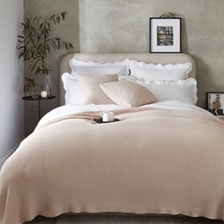The Thread
Find stories to inspire you, ideas from people we admire and our expertise for a home well curated, a wardrobe well put together, a life well lived.

Why a child’s bedroom doesn’t need to childish
The key is creating a space that is nurturing, warm, safe and fun, but can also grow with them, says Becky Sunshine


A space in which to grow
A baby needs specific pieces of furniture – the cot, the changing table and so on – but think ahead. The cot will be swapped out for a toddler bed, the space left by a changing table can become a play area or fitted with shelves for books and family photographs, a richly upholstered armchair for feeding the baby can transform into a cosy reading nook. Toy storage is also essential and plenty of it, so consider a space to tidy away the day’s fun and return the room to serenity for a restful sleep. Make it accessible too, so as your children grow, they can reach for books and toys themselves and eventually it can make way for a desk. Simple updates to a well-designed backdrop are the loveliest indicator that your child is growing up. Think about new cushions, rugs, and bedlinen as easy examples, that can be passed down.



Good design is for all ages
Creating a beautifully designed, happy home is for the entire family and that means a child’s bedroom can be just as tasteful and elegant as anywhere else in the house. But, that’s not to say it shouldn’t also be a playful, joyous space - very much dedicated to childhood. The key here is to make design decisions that feel timeless, or even ageless. There’s delight to be found in decorative touches, such as uplifting stripes on cushions, a placement of sweet florals and bedding trimmed with ruffles or contrast colours. Where young people are often most discerning is tactility: softness is king here. The stroke-ability of bedlinen is paramount, how deliciously squishy duvets, throws, cushions and pillows are. Favourite pyjamas are often those that feel most velvety against a child’s skin. And, remember that bedding is for more than sleeping – it’s for playing, reading, and plenty of snuggling, as well.


Creating a colour scheme
Working with a palette of adaptable neutrals means accents of colour can be introduced with restraint, to be easily updated as tastes move on. Choosing colours that have a sense of longevity, such as softest ivory, stone and olive, bring a feeling of balance and calm for both the children and adults who’ll spend time there, too. Warm, washed tones are so easy to live with and can be gently layered with contrasts to build interest. They also sit comfortably between classic and what feels right for modern life. As a child matures, they will want a say in how their room looks and feels, so starting with a simple, neutral foundation creates a pleasing space for individuality.
Simple, practical lighting
Quality, practicality, and simplicity makes the most sense when lighting a room for a child. Is that so different from an adult’s bedroom? Perhaps not. But remember, there’s also time spent playing on the floor, so directional light, from both the ceiling and the curated placement of lamps, offers versatility. A good reading light on the nightstand is essential for bedtime reading – one of life’s greatest pleasures at any age – but it’s also easy to create a little magic by adding a string of fairy lights around a bed, or even inside an indoor tent, for a space they really won’t want to leave.
Becky Sunshine is a freelance design, interiors and travel writer. She is the author of “Lee Broom: Fashioning Design” (Rizzoli)










